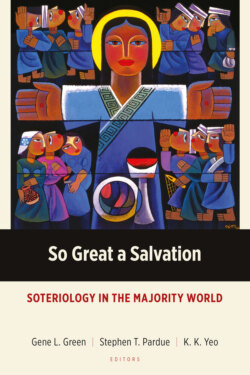Читать книгу So Great a Salvation - Группа авторов - Страница 14
На сайте Литреса книга снята с продажи.
Traditions
ОглавлениеThe preceding qualifications notwithstanding, this overview of Western soteriologies begins with the major traditions they encompass. For all their variety, each somehow prioritizes salvation from sin and its consequences. Plus all of them ultimately focus on salvation’s personal dimensions.[1] Yet each helpfully contributes an animating principle from which to learn.
Orthodox: Theosis beyond Mortal Corruption The Orthodox tradition has its focus and limits tied to early creedal consensus. Neither the informal rule of faith nor its later creedal formulations canonized a particular atonement theory or soteriology.[2] The first article of the Nicene Creed (“one God . . . maker of heaven and earth . . .”) implies that salvation involves the Creator’s establishing full and final lordship over the entire cosmos. Its second article (“one Lord . . . who for us and for our salvation . . .”) focuses on the Son’s incarnation for us and our salvation, rehearsing his divine identity and earthly pilgrimage. The “descent into hell” from the Apostles’ Creed only adds soteriological implications depending on debated interpretations. The second article’s closing reminder of divine judgment (“he will come again to judge the quick and the dead . . .”) and an eternal kingdom highlights the respective ends that soteriology puts at stake. The third article on the Holy Spirit, then, insists on baptism as the key soteriological entry point (“one baptism for the remission of sins . . .”) and implies a set of key end points: forgiveness of sins, the resurrection of the dead, and the life of the world to come.
Orthodox theologies emphasize this soteriological entry point of baptism, consistent with liturgical Tradition. They emphasize the end point of theosis, consistent with the focus on resurrection: such “deification,” or “divinization,” does not make a human into God himself, but it does involve the saved human “participating in the divine nature” in a creaturely way. Broadly speaking, this soteriology centrally addresses mortal corruption. Each human imitates Adam’s sin after having inherited his fallen mortality, with fleshly desires misdirected and disproportionate due to fear of scarcity. Christians experience God’s forgiveness through the sacrament of the Lord’s Supper. Salvation remakes humanity in union with the resurrected Christ by the Holy Spirit. Ultimately people transcend mortal corruption and become full (albeit still human) “partakers of the divine nature” (2 Peter 1:4) in resurrected bodies. In the meantime, the church’s liturgy mediates union with the incarnate Christ so that once again humans can grow in virtue. Ascetic figures and groups underscore Orthodoxy’s emphasis on efforts to undergo such transformation of mortal desire.
Catholic: Sacramental Renewal unto the Beatific Vision The Catholic tradition shares the creedal outline of salvation reclaiming God’s creation through the Son’s incarnation and atonement, with the Holy Spirit mediating union with Christ through the church. People enter into new life (“regeneration”) at baptism, appropriate renewing grace through the sacraments (especially the Eucharist), and will enjoy its completion in a form of theosis.
Although Orthodoxy rejects the Pelagian idea that humans can grow toward righteousness apart from redeeming grace, the Augustinian concept of original sin is different from the Eastern one. Classically, Catholic theology has Adam’s sin being not just necessarily imitated by humans (through corrupted desire stemming from cursed mortality) but imputed to them through real biological connection or another form of representation. Medieval Catholicism also made humanity’s soteriological end somewhat more specific, construing theosis in terms of the beatific vision (“Blessed are the pure in heart, for they will see God” [Matt. 5:8]). While transcending cognition, this beatific vision involves the mind’s eye, as it were. In between original sin and the beatific vision, medieval Catholicism applied an intricate legal and ontological construal of soteriological merit, along with a sacramental system for receiving grace.
Medieval Catholic soteriology’s more technical terms resulted in less communal and cosmic focus than earlier creedal consensus might have supported (and Orthodox liturgies might claim). Modern Catholic soteriology is more amenable to those broader soteriological aspects, consistent with the doctrines of creation and churchly catholicity. Meanwhile, both Catholicism and Orthodoxy emphasize human dignity and freedom to pursue renewal in the divine likeness, reflecting more positive anthropologies than many Protestant soteriologies.
